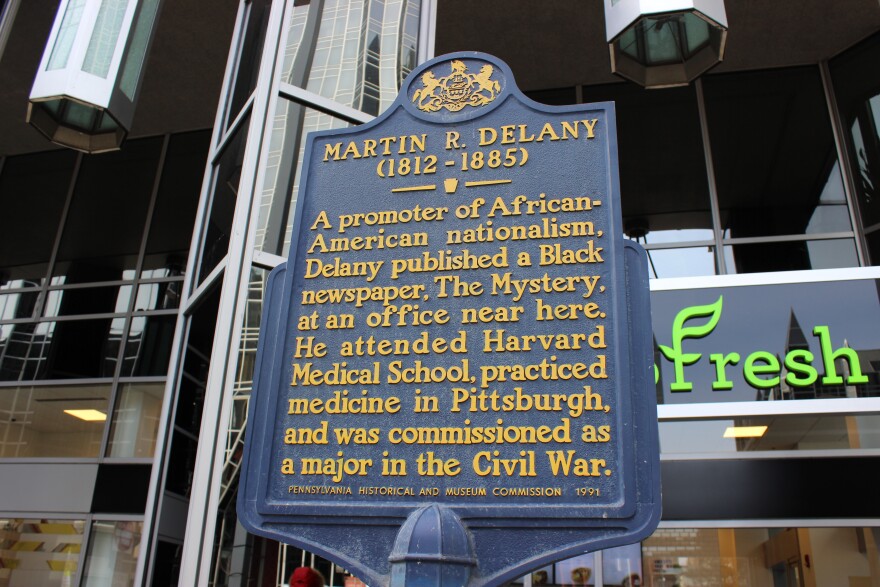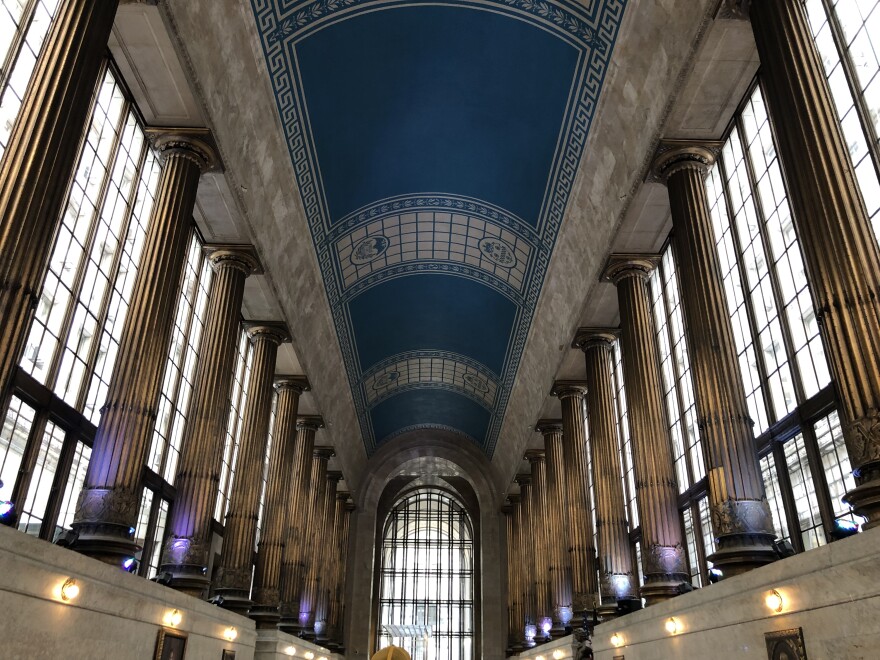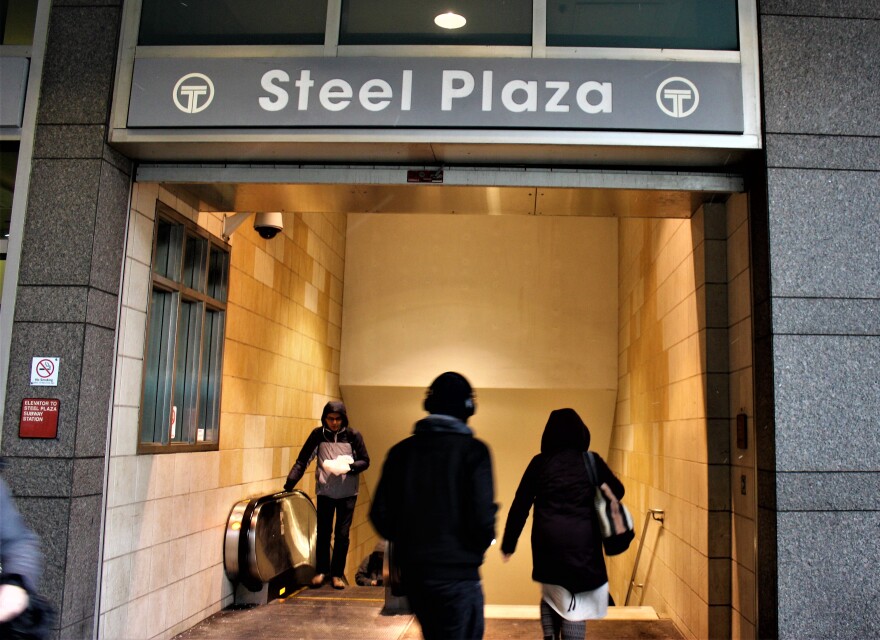Going a little stir crazy? Pittsburgh residents can take a break from idle time and work-from-home routines and get to know the city’s history while taking a stroll. Here’s a guide to one of a number of upcoming tours WESA is compiling for history lovers throughout the region.
The Golden Triangle: Approx. 40 minutes

Start in Market Square

Market Square was once called Diamond Square and central to the development of downtown Pittsburgh. The first Allegheny County Courthouse was constructed in the square, and for many years, a huge market building occupied the entire area. In the early 20th century, there was even a roller skating rink in the market.
Look around the square and you’ll see a couple of the city’s oldest restaurants, the Original Oyster House, which opened in 1870. Further down the square is Nicholas Coffee Company, which celebrated its 100th anniversary last year.
Keep turning and you’ll see one of Pittsburgh’s newest skyscrapers, the Tower at PNC Plaza. The building may have an imposing presence, but it’s actually one of the greenest high-rises ever constructed. It features an onsite greywater system (which takes used water and converts it so it can be used again to water plants, for example, instead of going down a sewer) and a solar chimney so the building doesn’t have to run a machine to ventilate excess heat.

Market Square is a mix of old and new and it’s still changing.
Can you find the shiny globe in the square? They were installed as part of a public art exhibition to raise awareness of climate change.
Make your way past the Primanti’s, cross Fourth Avenue.
PPG Place
With all the reflective glass, PPG place can feel like a fun house without the clowns. It was built for PPG Industries, which used to be called Pittsburgh Plate Glass. The company made--you guessed it--glass products like windows and mirrors throughout the region. The six PPG buildings contain 19,750 pieces of glass and opened in the 1980s.

In the winter, the square in the center becomes an ice rink and during the summer, it has a fountain where kids (and adults) come to play in the water.

You can see this building in a number of movies, including The Dark Knight Rises and Inspector Gadget.
In this plaza, there is a historical marker celebrating the legacy of Martin R. Delaney, a prominent abolitionist. Listen to a story about Pittsburgh’s history with the Underground Railroad.
Do you see any dinosaurs? Take a selfie in the mirrored glass.
Turn left and head down Fourth Avenue (away from the glass buildings and skywalk connecting them)
Fourth Avenue
Almost immediately you’ll see a stately building with a big red door. This is the Burke Building, Pittsburgh’s first large office building, constructed in 1836. It's quite different from the modern PPG buildings.
Its style is considered Greek Revival, which is an architectural movement you might recognize from the U.S. Supreme Court Building or Capitol Building. Can you see the similarities?
Keeping walking until you get to 223 Fourth Avenue, the Benedum-Trees Building. This once belonged to an oil company and is more than 115 years old.

You’re about to reach Fourth Avenue’s intersection with Wood Street. Normally there would be a lot of college-age students walking around here, because this is the campus of Point Park University. The school owns many of the buildings nearby and, in a number of cases, has kept their original facades.
Cross the street on the First National Bank side and then look back to where you just were--this is the Arrott Building, constructed in 1902. James Arrott funded this building. He’s remembered, as Robert Morris University’s Mark Houser points out, for being the “bathtub king,” because he was one of the most successful enameled iron bathtub makers in the city. Notice the intricate decorations throughout the exterior.
Alright, turn back around and look at the entrance of First National Bank. What do you see? Is there a lion head watching you? Back in the late 19th and early 20th centuries, Fourth Avenue was home to Pittsburgh’s financial district. Banks were everywhere along this street and lions were included in many of the exteriors because they have historically been considered protectors.
Here’s a story we did as part of our Good Question! series all about the lions on Fourth Avenue. If you start listening to it now, you can hear almost all of it by the time you get to our next stop.
Grant Street
The huge structure in front of you is the City-County Building. It’s home to Pittsburgh and Allegheny County offices and people like the Mayor and City Councilors all work there each day.
This building celebrated its 100th birthday a few years ago. It’s made in the Beaux Arts style, which means it has elements of French architecture. Do you see the people sitting near the words “City-County Building?” They’re placed around the city’s seal, which was based on the family coat of arms of a military strategist named William Pitt the Elder (Pittsburgh was named after him).

Look a bit higher and you’ll see columns and flags. During special occasions, this part of the building can be lit in different colors -- green for St. Patrick’s Day, pink for Breast Cancer Awareness Month.
If you’re interested in learning more about the first African American City Councilman and the first female City Councilwoman, here are two stories about Paul Jones and Irma D’Ascenzo.They paved the way for diversity in Pittsburgh city government.
Outside there’s a statue of a man with his hands in his pocket. This is Richard Caliguiri, Pittsburgh’s 55th mayor. He’s remembered for starting what’s known as the city’s Renaissance II plan, an urban renewal period that saw the construction of the U.S. Steel Tower and the David L. Lawrence Convention Center. The statue was made by an sculptor named Robert Berks.
Cross the street toward the City County Building and start walking down Forbes Avenue. This street was named for General John Forbes, who gave Pittsburgh its name in 1758 in honor of Sir William Pitt the Elder. Forbes also ordered construction of Fort Pitt near the site of Fort Duquesne, which French forces had burned and abandoned Fort Duquesne before Forbes’ forces reached the Point.

The Allegheny County Courthouse
On your left, you’ll notice a giant brick structure. The stones to make this massive building were gathered at a place called Coal Hill, on what’s now Mt. Washington. Here’s a story about Pittsburgh’s history of coal mining.
This building is an example of Romanesque Revival architecture, which is why it kind of looks like a castle. It includes a lot of arches and pillars and was completed in 1888.
Often the courtyard space is open--you can see the large fountain in the middle. Keep walking until you reach the intersection with Ross Street.
This tour is one of a series of historical walking routes curated by WESA. Check back to the website for more.
Turn left and you’ll see a large bridge, often referred to as the “Bridge of Sighs” (based on one of the same name in Italy). It connects the Courthouse to the former Allegheny County Jail. If someone was arrested, they’d be taken from the courthouse to the jail, so people imagined the prisoners would be distressed while crossing the span.
After you pass under the bridge, you’ll come to an intersection with Fifth Avenue. Cross Fifth Avenue and continue on Ross Street.
BNY Mellon and Mellon Square
The building on your left is BNY (Bank of New York) Mellon Center, a 55-story skyscraper. It’s the second-tallest building in the city (you can also see the tallest, the 64-story U.S. Steel Tower, now mostly occupied by UPMC, in front of you) and was completed in 1984.

Underneath BNY Mellon is a stop on Pittsburgh’s light rail system, the T. The Mellon building and the T lines were built around the same time and a line underneath the structure made sense based on its alignment with Pennsylvania Railroad Station and existing underground tunnels.
Continue down Ross Street and you’ll notice a park, complete with rideshare bicycles and, all the way at the corner of Ross and Sixth avenues, another entrance to the T station. This intersection was once part of the original Lincoln Highway, one of the earliest routes for cars to cross the United States (it started in New York City and ended in San Francisco). This route cut through downtown Pittsburgh from the North Side, crossing this intersection and east toward the Upper Hill District, before going through Shadyside, East Liberty and out of the city at Wilkinsburg.
Turn left at Sixth Avenue, following the outline of Mellon Green parklet. Take a step inside the park, it’s an oasis of nature in the middle of a (usually) bustling downtown. There’s a lovely fountain there and plenty of benches to rest.
Smithfield Street
When you’ve rested up, cross Grant Street and continue down Sixth Avenue. To your left you’ll see the Omni William Penn Hotel. When it opened in 1916, it was one of the first to have a phone, electricity and private bathrooms--considered luxuries in that day.
On your left is Mellon Square, an urban park with a lot of history. It was once home to Turner Hall, where the world’s first labor union, the Federation of Organized Trades and Labor Unions, met (there is a plaque near the intersection with Smithfield Street).
The far corner housed Davis Theatre, where the world’s first broadcast of a live performance was made by KDKA-AM Radio.
Now, it has a couple of fountains, one in the center of the square and another cascading alongside the staircase. Performers play there regularly in the warm months.
Turn right at Smithfield Street by the Brooks Brothers store. You’ll pass the downtown branch of the Carnegie Library, a system created by industrialist Andrew Carnegie. Here’s a history of the libraries with his name, of which there are now 2,509 throughout the United States.

Can you find a mural with Andrew Carnegie and Andy Warhol?
Smithfield United Church of Christ is the large house of worship you’ll see right after the Carnegie Library. Founded by German settlers, it’s the oldest organized church in the city and dates back to 1792. Its aluminum steeple can be seen from different spots throughout the city.
If you look to your right, you’ll see Strawberry Way, one of Downtown’s decorated alleyways. Alleys don’t have a great reputation, so the city has tried to make its more inviting.
You’ll also pass by S.W. Randall Toyes and Giftes, a 50-year-old speciality shop. Swing another left at the Burger King at Seventh Avenue and walk until you see the mural on the corner.

Liberty Avenue
The mural is called “Yesterday’s Tomorrow” and was completed by artist Brian Holderman in 2006. Its vibrant colors are meant to illustrate what the city could look like in the future.
If you want a quick detour (and if you’re going at night, this is recommended), go to the right, across the street from the mural and then cross Liberty Avenue toward Garrison Place. This alleyway has a great light installation.
When you’re finished, cross back and turn left onto Liberty Avenue.
This street has been a main thoroughfare for a long time, but it wasn’t always as nice as it appears today. “Liberty Avenue used to be a smattering of restaurants and retail shops butting up against massage parlors, adult video stores and triple-X performance spaces,” Kathleen Davis writes for this Good Question! installment.
Across the street you’ll see the Harris Theater. It originally opened as the Art Cinema in 1931. For years it featured controversial, racy films. It was later named after John P. Harris, co-founder ofthe original Nickelodeon theater.

This area is part of the Cultural Trust, which houses many of the city’s theaters and other art and performance spaces.
Soon you’ll see an Arby’s ahead of you. Take a quick detour and turn left onto Strawberry Way, and then onto Coffee Way behind the fast-food chain. There you’ll find four medallion-like profiles carved into the brick. This building was once the Arbuckle Coffee Company and two figures are identified as George Washington and Abraham Lincoln, but it’s unclear if the other two are Mary Croghan Schenley or Jane Grey Swisshelm, and an American Indian or a rendering of Lady Liberty.
Back to Liberty Avenue. You’re going to pass a triangular building, which is home to another light rail T stop, Wood Street Station. Upstairs, there’s actually a gallery that typically hosts a lot of interactive art.
At the intersection with Seventh Avenue, cross Liberty Avenue and head down Seventh toward the Allegheny River.
The theaters
The Benedum Center will appear on your right, with its massive marquee and flashing lights. Originally the Stanley Theater, the structure was built in 1927 as a movie theater. It houses nearly 90 chandeliers, including a giant one with more than 50,000 crystals (listen to that story here).
At the next intersection you’ll see a historical marker designating the Pittsburgh Agreement, when the country of Czechoslovakia was formed. A whole country was created right in downtown Pittsburgh!
Now you’re going to pass by the Greer Cabaret Theater, Heinz Hall and the O’Reilly Theater. These are all staples of Pittsburgh’s arts scene. Take some time to listen to the previously recommended stories about them while you enjoy their architecture.
When you reach the intersection of Penn Avenue and Stanwix Street, look to what’s now a building owned by Allegheny Health Network. This was once the Joseph Horne’s Department store. Just above the sign is a globe protruding from the wall and to its left is a high water marker. This is how high water rose during the 1936 St. Patrick’s Day flood. There are many of these markers around the city. But because flooding was so common back then (the region’s protective lock and dam systems weren’t complete), several department stores, including Horne’s, actually owned boats just in case they needed to move their products out of the building quickly.

Move forward, crossing Stanwix Street toward the big glass building with a T on it.
Can you find the clock on the Horne’s building?
The Point
We’re reaching the end of this tour of downtown Pittsburgh. To your left is another light rail T stop, one of the most recently upgraded, Gateway Center. Keep walking down Penn Avenue, but take a look to your left at how the city has implemented parklets into its design.
Also to your left is an art installation called “Pipe Dream IV” done by Sister Josepha Filkosky in 1970. According to the Pittsburgh Arts Council, the piece “explores movement through the thrusting and turning of the pipe” and was made for the Three Rivers Arts Festival, which takes place at Point State Park each summer.
Can you find the renovated dumpster-turned-flower bed?
You’ll know when you’ve reached Point State Park when you hit the vast green space before you.
This park was where the city of Pittsburgh was born: Fort Pitt and Fort Duquesne were both built here to protect claim over the region’s three rivers, the Monongahela, Allegheny and Ohio. Now, it’s a 36-acre state park culminating at the confluence of the three rivers.
There are rumors that the fountain at the point of the park is powered by an underground fourth river, but that’s not technically true. Listen to our story about the alleged fourth river here.
And here’s where I’ll leave you to enjoy your day. Thanks for coming on this journey through downtown Pittsburgh and here’s where you can find more stories about Pittsburgh history and culture.
*This story has been updated to clarify the history of Forbes Avenue, the Carnegie Libraries and other elements of downtown structures.






